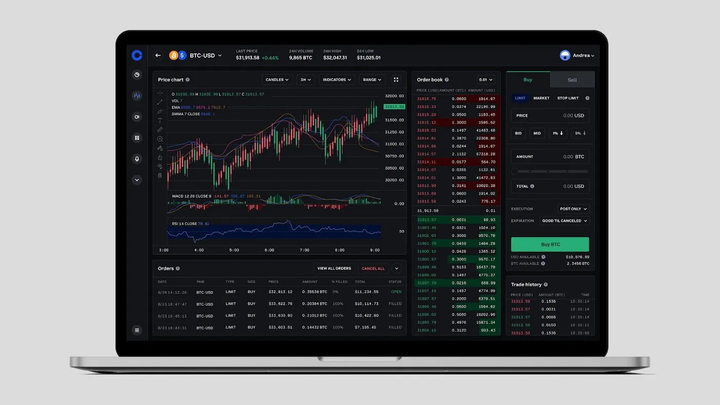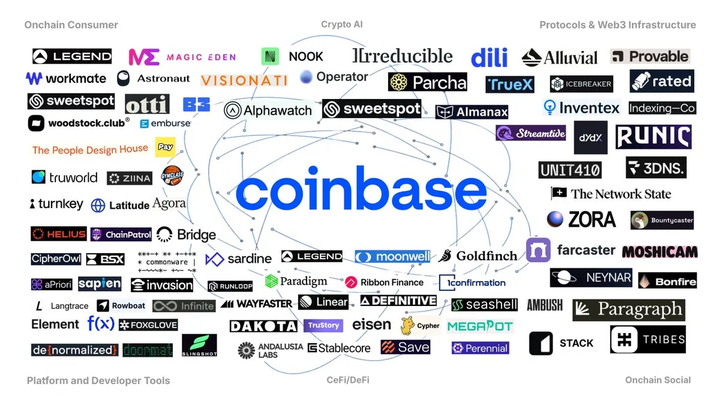The Ambition Beyond Exchanges and the Dilemma of the Crypto Industry
Author: Jay Jo
Source: Tiger Research
Translation: Baihua Blockchain

Coinbase has evolved from a simple trading platform to building a full-stack cryptocurrency ecosystem through the Base chain and The Base App.
The company has expanded its influence in the cryptocurrency industry, similar to Google's model, by acquiring multiple crypto startups and leveraging a strong network of Coinbase alumni.
Coinbase's strategic moves clearly help promote the adoption of cryptocurrency. However, this also creates new centralized structures and brings challenges on how to balance decentralized values.
1. Coinbase: Ambition Beyond a Trading Platform
Coinbase became the first cryptocurrency trading platform to be listed on a securities exchange in April 2021, going public on Nasdaq through a direct listing. This event was not just an IPO for a single company, but rather a turning point symbolizing the entry of the cryptocurrency industry into the mainstream financial system.
The name "Coinbase" is also symbolic, originating from the "Coinbase Transaction" in Bitcoin, which is the first transaction recorded when a new block is created, representing the moment cryptocurrency entered the world. The company name reflects its firm commitment to being the starting point of the cryptocurrency ecosystem.
The symbolic significance of Coinbase goes beyond its name. The company has expanded its business scope based on its core trading platform, building a vast ecosystem. It launched the Ethereum-based Layer 2 chain Base and introduced The Base App (TBA) during the "A New Day One" event. These developments indicate that Coinbase is constructing a full-stack cryptocurrency ecosystem that encompasses everything from infrastructure to applications.
2. Crypto Full Stack: Trading Platforms, Infrastructure, and Consumer Applications
2.1. Trading Platform: Coinbase's Reliable Cash Cow
Coinbase's core business is undoubtedly its trading platform, which provides cryptocurrency trading services to a wide range of users, from individuals to institutions, generating revenue through trading fees. As of 2024, trading fee revenue accounts for about 60% of total revenue, amounting to approximately $4 billion. The relatively stable trading fee income lays the foundation for Coinbase's new business expansion, similar to how Amazon expanded multiple businesses using AWS as its cash cow.

Source: Coinbase
Moreover, the value of the trading platform is also reflected in its strategic scalability. As a core gateway connecting fiat currency and cryptocurrency, the trading platform provides Coinbase with a large user base and transaction data. This position makes it a strategic hub that naturally attracts users into a broader ecosystem. The trading platform provides Coinbase with financial stability and strategic expansion capabilities, serving as the core foundation for ecosystem development.
2.2. Base Chain: The Leap from Off-Chain to On-Chain
The Base chain is an Ethereum-based Layer 2 blockchain directly built by Coinbase. Through this chain, Coinbase can expand from its trading platform business into the on-chain domain.

Source: Base
This expansion is necessary due to the structural characteristics of the cryptocurrency ecosystem. The cryptocurrency ecosystem is divided into off-chain and on-chain environments. The trading platform primarily provides trading services between fiat currency and cryptocurrency in the off-chain environment.
However, the actual applications of cryptocurrency occur in the on-chain environment, such as cryptocurrency-based loans and governance participation. For example, after purchasing cryptocurrency on Coinbase, users transfer it on-chain to participate in specific DeFi protocols. This means Coinbase faces structural limitations in directing users to other ecosystems.
The Base chain addresses these limitations. Now, users can remain within Coinbase's ecosystem even after purchasing cryptocurrency and withdrawing it. Just as Apple controls both hardware and software, Coinbase can now manage the entire user journey from the trading platform to infrastructure, which is significant.
2.3. TBA: The Final Piece of the Crypto Ecosystem Puzzle

In July 2025, Coinbase announced the launch of the on-chain super app TBA, moving towards a larger vision. Its strategy is not limited to locking in users through the trading platform but also providing users with practically usable application layers through Base infrastructure. Although there are many decentralized applications (dApps) based on Base, they are scattered and difficult to find in one place. Even if the Base chain performs excellently or has low fees, its significance is hard to realize if ordinary users cannot easily access it.

Source: Base
TBA integrates the core elements of the cryptocurrency ecosystem—trading platform, infrastructure, and applications—into one platform, providing a seamless user experience. Users can make cryptocurrency payments and transfers, generate income through Farcaster-based social services, and use it immediately for online or offline payments, bringing a new on-chain experience. The synergy of various services creates a powerful collaborative effect, building a vast on-chain economic ecosystem. This significantly lowers the barrier to participating in the on-chain economy, completing the final piece of Coinbase's construction of a large ecosystem.
3. Coinbase Builds a Crypto Empire
Coinbase is no longer just a trading platform. The company has built blockchain infrastructure and consumer applications on top of its trading platform, evolving into a vast empire that encompasses the entire cryptocurrency ecosystem. Additionally, through an aggressive acquisition strategy, Coinbase has further expanded into broader fields. For example, the company has acquired the token management platform LiquiFi, zero-knowledge proof technology company Iron Fish, Web3 advertising platform Spindl, and cryptocurrency derivatives trading platform Deribit, extending its reach into various areas of the Web3 industry.

Source: Tiger Research
These actions indicate that Coinbase is trying to control all touchpoints related to cryptocurrency like an aircraft carrier. Furthermore, its relationship with Circle, the issuer of the USDC stablecoin, is particularly noteworthy. Coinbase is a major shareholder in Circle, receiving a portion of the USDC interest income, going beyond simple equity investment. If Circle goes bankrupt or fails to fulfill its income distribution obligations, some USDC-related rights will transfer to Coinbase. This shows that Coinbase almost controls the core infrastructure of the cryptocurrency ecosystem.

Source: Coinbase Ventures
Coinbase's expansion strategy is not only achieved through acquisitions. Another core strategy is to spread influence in the cryptocurrency industry through Coinbase alumni, similar to the operation model of the PayPal Mafia. The company has invested in over 40 Web3 startups founded by former Coinbase employees and established partnerships, continuously building a closely collaborative network. Notable examples include Polychain Capital, founded by Coinbase's first employee Olaf Carlson-Wee, and major Web3 projects like dYdX, Farcaster, Zora, and B3, founded by Coinbase alumni.
We still view Coinbase as a trading platform, but its actual operation resembles that of Google in the Web2 era. Just as Google started with search and dominated the entire digital ecosystem, including advertising, cloud, and mobile, Coinbase has also started from its trading platform business to build a vast empire covering all areas of the cryptocurrency ecosystem.
4. A Trading Platform-Centric Crypto Market: Good or Bad?
Coinbase is building a vast empire. The strategic moves from the trading platform to the Base chain and then to TBA are clearly well thought out. However, we need to consider its positioning within these radical strategies.
Cryptocurrency advocates decentralization, but today it is returning to centralization in pursuit of convenience. Users voluntarily enter the Coinbase ecosystem and have no reason to leave. This essentially reshapes a structure similar to traditional finance.
This change is not entirely negative. Integrated platforms like TBA bring tangible benefits to users. Users can access all services in a single application without complex wallet connections, frequent platform switches, or worrying about high Gas fees. The process seamlessly connects income generation through social activities to actual payments. Coinbase's model clearly aids in the adoption of cryptocurrency.
However, we cannot overlook a key point. Cryptocurrency aims to achieve decentralization, but today it forms a new centralized structure in pursuit of convenience. Users voluntarily remain in the Coinbase ecosystem, finding no reason to leave. This is not fundamentally different from the traditional centralized financial structure we are trying to escape.
The market has chosen convenience, and reversing this trend seems difficult. What is now important is to find a balance between centralized convenience and decentralized spirit. The real challenge lies in building an ecosystem that protects user choice through healthy competition and continuous innovation while retaining the core values of cryptocurrency.
Article link: https://www.hellobtc.com/kp/du/07/5988.html
Source: https://reports.tiger-research.com/p/coinbase-tba-eng
免责声明:本文章仅代表作者个人观点,不代表本平台的立场和观点。本文章仅供信息分享,不构成对任何人的任何投资建议。用户与作者之间的任何争议,与本平台无关。如网页中刊载的文章或图片涉及侵权,请提供相关的权利证明和身份证明发送邮件到support@aicoin.com,本平台相关工作人员将会进行核查。




